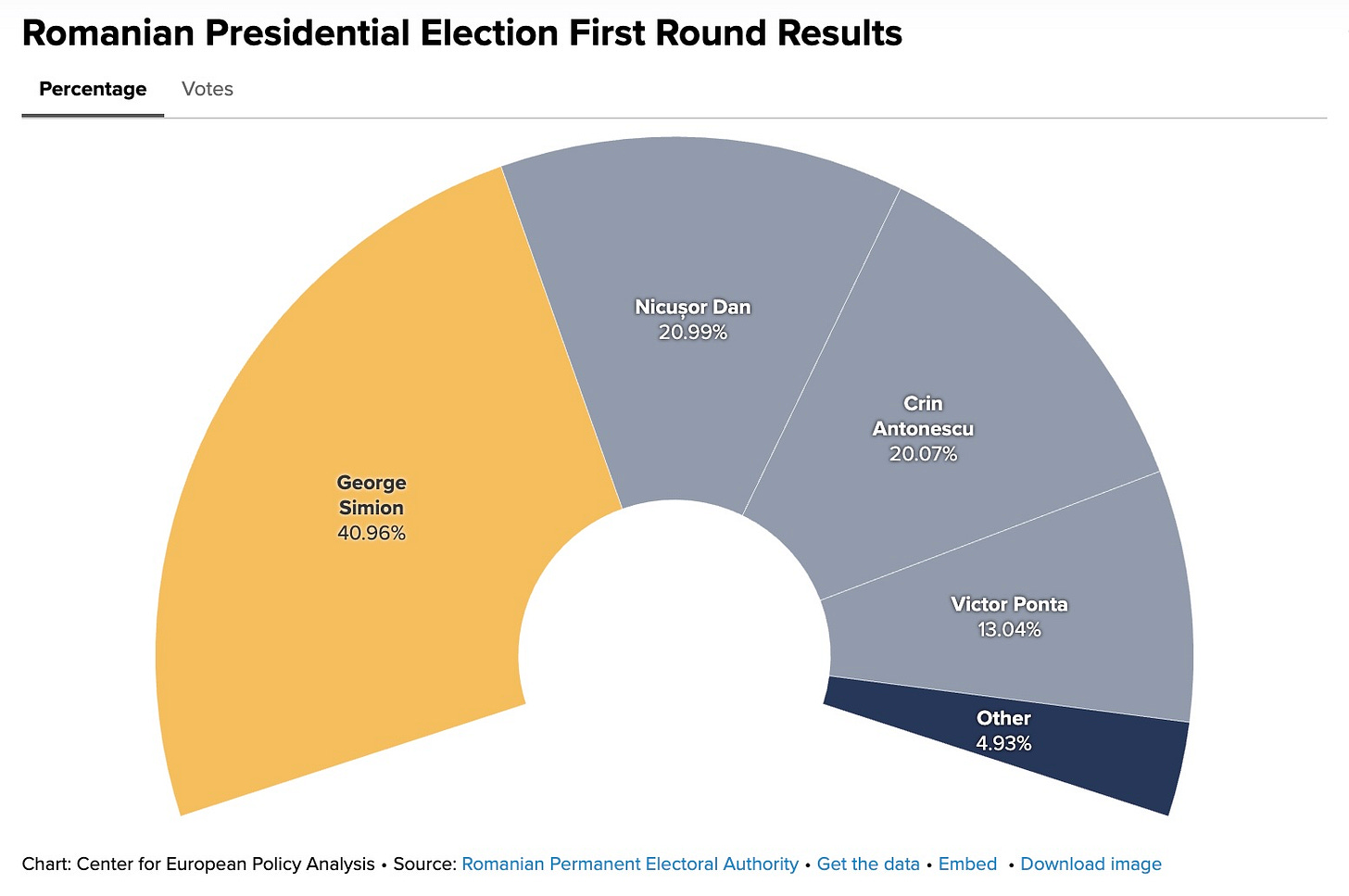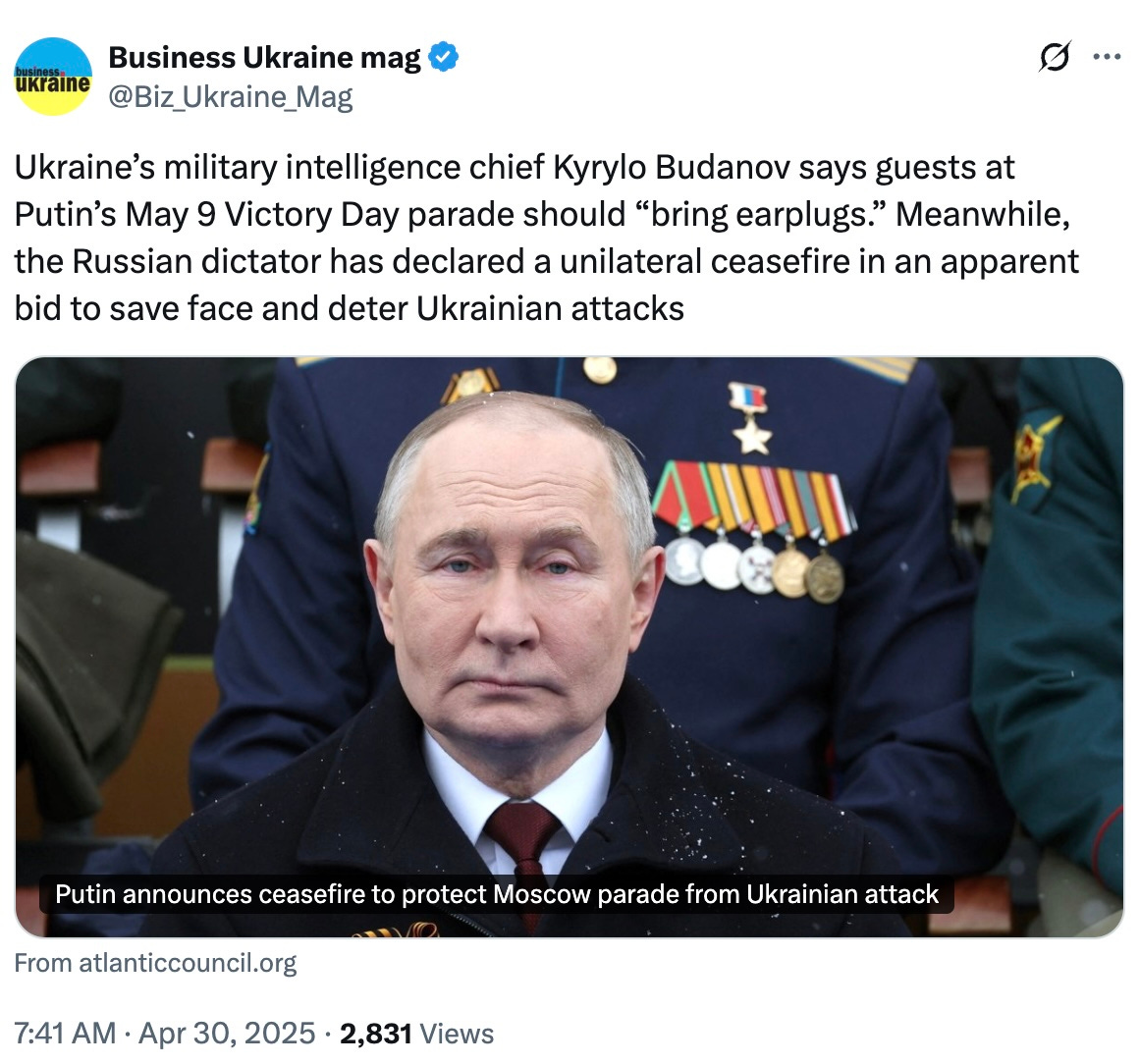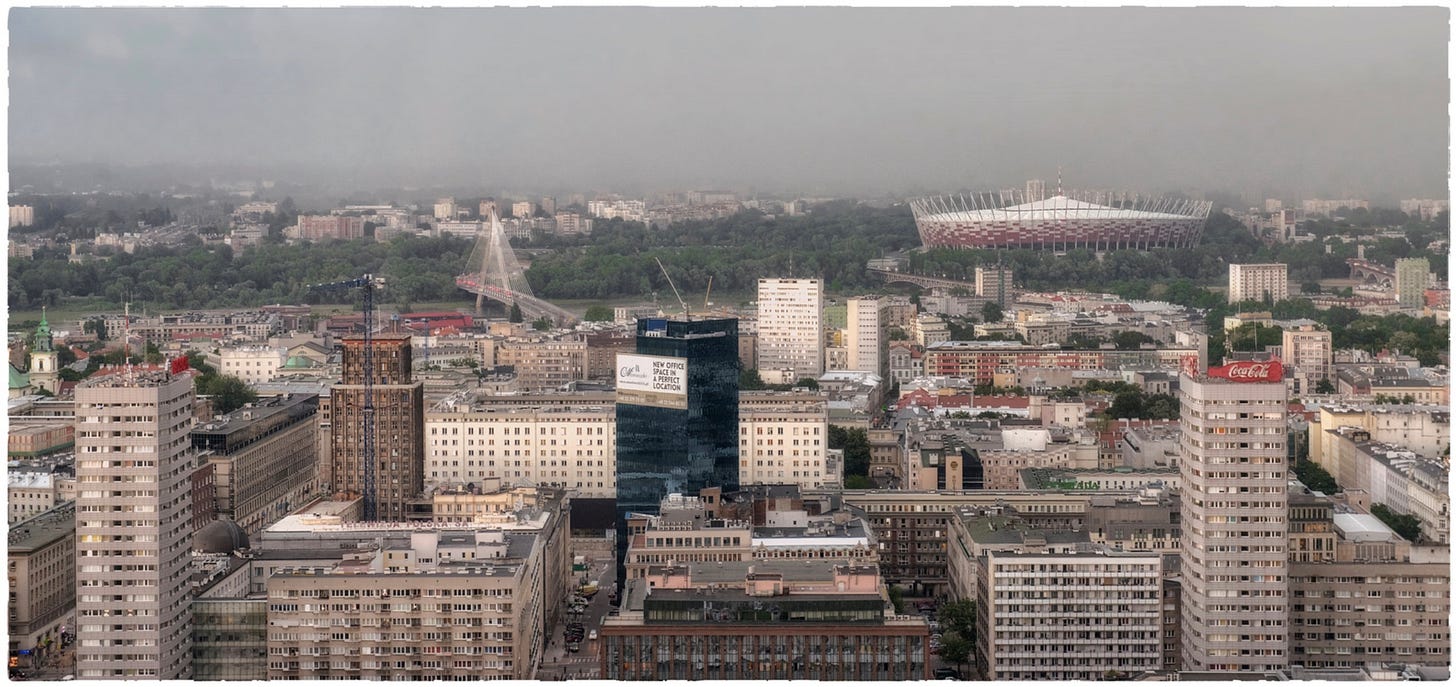Welcome. Common Sense and Whiskey a short, sharp, once a week look at the world out there.
This week I wrote about the inexplicable squandering of American standing in the world over just three presidencies. I’ll take that a little farther today, and we’ll look at the coming, very important elections in Poland and Romania, and generally consider the current state of Europe. Finally, who doesn’t love a parade?
If you find any insights here, please consider subscribing to Common Sense and Whiskey. It would be great if you could contribute, but there are no paywalls here. You can always read the whole thing.
Let me know what you think.
Let’s go:
VICTORY DAY: On May 7th, 1945 German General Alfred Jodl signed Nazi Germany’s unconditional surrender to Allied forces at General Dwight D. Eisenhower's headquarters at Reims, France. According to the agreement hostilities would officially cease at 23:01 Central European Time on May 8th, which was 1:01 on May 9th, Moscow time.
Further, Stalin arranged a second ceremony in Berlin on the day after the Reims ceremony, May 8th, arguing that the surrender at Reims was a preliminary document and not legitimate. The second surrender ceremony was held just before midnight on May 8 at a former German military school in Karlshorst, Berlin, with effect at 00:01 Moscow time on May 9. Thus—for both reasons—yesterday was Victory in Europe day for the US and Europe, and today is Victory day for Russia.
Which means Moscow’s 80th anniversary Victory Day parade was today. All week we heard speculation that Moscow was withdrawing forward deployed air defense systems back east toward Moscow to protect the capital from Ukrainian attack.
In spite of the obvious fact that attempting to assassinate the leaders of China, Brazil and elsewhere would be unwise, Ukrainian President Zelenskyy did his part by declaring he was unable to guarantee the safety of dignitaries who might travel to Moscow for the event. Ukraine’s military intelligence chief Kyrylo Budanov suggested parade attendees should “bring earplugs.”
Ukraine’s military’s drones harassed Moscow’s airports, causing repeated shutdowns all this week. Serbian President Aleksandar Vučić’s plane was reportedly forced to divert to Baku because of the peril in Russian airspace.
In the end, as this morning’s New York Times has it:
“the entire city center was blocked for traffic and metro stations were shut down in the vicinity of the Kremlin. Access to the internet has been sporadic, including through landlines.”
But all the dignitaries survived the parade. In effect, Vladimir Putin had held Xi Jinping and the other foreign leaders as human shields against Ukraine.
•
The leaders of the countries on the map below were on the guest list, as well as Mahmoud Abbas, President of Palestine and the presidents of Republika Srpska, South Ossetia and Abkhazia, places not on the map. Thongloun Sisoulith, President of Laos, cancelled on Wednesday. It looks like Prime Minister Nikol Pashinyan of Armenia was to attend but wasn’t on the guest list. President Ilham Aliyev of Azerbaijan also cancelled.
•••••
This week I wrote (in Managing American Decline) about the inexplicable squandering of American standing in the world over just three presidencies. A factor I didn’t expand upon in the article was the acute technological change that bracketed all three boomers’ presidencies together. Consider:
On Bill Clinton’s inauguration day, home computers were beige plastic boxes with cathode ray tubes. Netscape released its first web browser after his first term midterms, introducing the internet to everyday consumers. Phones were landline, music was mostly cassettes. Movies were on VCRs.
When Dubya swore his first oath, you dialed up the internet. Anybody calling while you were online got a busy signal. Remember busy signals? Google was two years old. Cell phones weren’t smart yet.
By the time Obama put his hand on the bible, America had broadband. Facebook and Twitter were two years old, the iPhone one. Music and videos no longer came on physical media.
Mobile phones begat apps, and GPS begat map-reading illiteracy. BlackBerries were past their prime as status symbols. You carried the internet in your pocket and you were always online. Tech was becoming personalized in ways good and bad.
By the end of our baby boomer presidents’ 24 years, Siri and Alexa were pioneering AI. Everything streamed. Old TV, music and print media models collapsed. Algorithmic curation of news feeds, recommendations, everything really, changed how people took their reality, and how they chose their leadership.
We now expressed ourselves on platforms mediated digitally. Scantly regulated tech giants shaped public discourse, the way we behaved and, increasingly what we thought.
•••••
POLAND: Presidential elections begin next weekend, May 18th, with a runoff on June 1st. For this frontline state bordering Ukraine, from which the bulk of western aid is staged, it’s an important election.
Since December 2023 the Europe-friendly Civic Platform (KO in its Polish acronym), headed by Prime Minister Donald Tusk, former president of the European Council in Brussels, has run Poland. It defeated the far right Law and Justice Party (PiS) party, which regular readers will know is authoritarian, deeply conservative and xenophobic. Over its most recent eight years in power it undermined the rule of law, attacked the press, restricted minority rights and packed the Polish judiciary.
The election of Civic Platform was a vast improvement, but Civic Platform’s victory is incomplete, because the PiS, in the person of incumbent President Andrzej Duda, still holds the presidency, and acts as obstructionist, holding back Civic Platform’s attempts to undo its rule (Duda is term limited and cannot run again).
In these elections Civic Platform (KO) aims to remedy that. The candidates for the two leading parties are 53 year old Warsaw Mayor Rafał Trzaskowski for Civic Platform and Karol Nawrocki, 42, for PiS. Mayor Trzaskowski ran a close race for the presidency in 2020, narrowly losing to Duda, and despite a wobbly patch in late April, has maintained a durable, if slightly shrinking, lead in the polls.
Nawrocki flew to Washington last week in hopes of a divine blessing from the American president. Donald Trump granted him an Oval Office meeting, and he was given the populist’s royal treatment, seeing Secretary of State Marco Rubio, Speaker of the House Mike Johnson, House Judiciary Committee Chair Jim Jordan, and Secretary of Health and Human Services Robert F. Kennedy Jr.
Nawrocki’s partisans made much of the visit, while Former PiS Deputy PM Roman Giertych, now a member of the Sejm (parliament) for Civic Platform, dismissed it, calling the American President Putin’s “friend” and accusing him of “brazenly interfering in the elections in Poland.”
Polling has closed slightly as the election draws near, with a poll of polls showing Rafał Trzaskowski’s lead narrowing from 34/23 a month ago to 32/25 on May 7.
•••••

ROMANIA: Romania's presidential runoff is the same day, May 18. In it the far right candidate George Simion faces centrist independent Nicușor Dan, now in his second term as mayor of Bucharest.
Simion, who replaced the earlier disqualified Calin Georgescu as the far right’s candidate, took 40.96% of first round voting. The combined total of the two centrist candidates, Dan and Crin Antonescu, totals 41.06%.
This suggests that in theory, if Dan consolidates support from Antonescu voters, the runoff could be a tight race. Couple of points:
Simion, who wears a red MAGA-like cap while campaigning, often appears with the disqualified but still popular Georgescu, and his supporters might expect him to have a role in a future Simion government.
Meanwhile Dan’s victory (as an independent) upset the more establishment candidate Antonescu, who is a former everything: interim President, President of the Senate, Minister of Youth and Sports and leader of the National Liberal Party. Consolidating support among Antonescu voters won’t be as natural as on the far right.
One other point: Victor Ponta, a former prime minister and independent candidate, came fourth in the first round with 14% and did not advance to the runoff. Ponta’s voter based is nationalist, and he has expressed support for a government coalition between the Social Democrats (PSD) and Simion’s Alliance for the Union of Romanians (AUR), indicating a possible alignment with Simion's policies.
Seemingly toward that end, after the first round of voting the Social Democrats announced they were pulling out of the ruling coalition, leaving a minority caretaker administration. Thus, indications are that if Simion wins the runoff, the Social Democrats and Simion’s AUR would attempt to form a government.
In a televised debate on Thursday night, Simion didn’t exactly rule out whether he would participate in allowing aid into Ukraine: He said his position “towards Russia's war of aggression is neutrality, not escalation, not feeding with weapons, and perfect alignment with the policies of our strategic partner, the Trump administration.”
We’ll look at what it will all mean for Ukraine and Moldova in a future column.
•••••
If you’re reading this as an email, your provider may clip this article before the end. Try clicking on ‘view entire message’ to see the whole thing, or you can always read everything at Common Sense and Whiskey online.
•••••
THE LARGER PICTURE: In Germany, the curtain briefly got stuck as it tried to rise on the Merz era. In a confirmation vote meant to be a formality on Tuesday, eighteen of the new Chancellor’s own coalition members may have voted against him. It was a secret ballot in the Bundestag, so it’s impossible to know who the troublemakers were, but the vote denied Merz the votes needed to be sworn in. The situation was rectified in a second vote but the act of protest lingers as an embarrassment for the new Chancellor.
Still, he was off to France and Poland on his first full day in office, reaffirming German commitment to the so called Weimar Triangle and declaring in Warsaw a “new beginning in Polish-German relations”. Notes from Poland reported Polish Prime Minister Tusk:
“announced that he had proposed to Merz extending the presence of German Patriot missile batteries that were deployed last year to protect the airport in the Polish city of Rzeszów, which is the main hub for equipment and officials travelling in and out of Ukraine.”
Meanwhile, the outlook for post-Macron leadership in France (with the next election expected by April 2027) couldn’t be more muddled with no apparent successor in the President’s Renaissance party, the prospects of the National Rally on hold pending Marine Le Pen’s appeal of an embezzlement conviction and the left at loggerheads with itself.
In the United Kingdom the rise of Reform, a farther-right-than-the-Tories party led by Brexit advocate Nigel Farage gathers steam, having just thumped the Tories in local council elections, while the ruling Labour party, fronted by anti-charismatic Prime Minister Keir Starmer, continues to pursue its grumpy version of austerity.
The FT reports that “at the last general election, combined support for Labour and the Tories was down from 82 per cent in 2017 to just 57 per cent. Last week, it was barely above a third,” in yet another example of the center-right giving way to the farther right.
So just now Germany, France and the UK, the former Big Three, look anything but. Which makes the prospects for centrism continuing to carry the day increasingly bleak. Put another way, there’s not much reason to believe the rise of the far right won’t continue. Like, perhaps, in Romania.
We’ve explored in previous editions of CS&W how a cluster of Putin-friendly support is coming together in southeastern Europe, in governments in Hungary, Slovakia, Serbia, with strong Pro-Putin opposition parties in Germany, Austria and Czechia. (Worth noting: while the leaders of Slovakia and Serbia attended Moscow’s Victory Day event, Hungary’s Viktor Orban did not.) The Putin-friendly cluster is seen on this map, which imagines a Simion victory in the Romanian runoff.
Note that with a Simion victory in Romania, three of the four NATO states which border Ukraine would be led by governments sympathetic to Putin, putting more pressure than ever on Poland to supply Ukraine with war materiel. Note too that Poland is bordered on the east by Belarus, essentially a hostile Russian satrapy. Poland’s northern border, just off this map, is Kaliningrad, a highly militarized Russian exclave. So Poland has its hands full.
Also worth noting on that map is EU aspirant Moldova’s increasingly dire position in the event of a Simion victory. Simion and his AUR party have called unification of Romania and Moldova a "historical imperative,” and he has been banned from entering Moldova (and Ukraine) due to his political activities. There’s much more to that story, the stuff of a future column.
•
The UK and France talked a bold, brave game for a time, but it still feels like Europe is fundamentally unable to imagine its geopolitical place in the world without the United States as an ally. Remember the urgency with which London and Paris began to assemble their ‘coalition of the willing’ to send to Ukraine in the event of a cease fire? Where did that go?
At the same time the Putin-friendly cluster looks set to grow, with the addition of Romania, and the southern tier, to whom war feels far away, lags on defense spending and contribution to the war effort, as shown in this table compiled by ChatGPT:
Phillips P O’Brien writes that:
“Most Nordic and Baltic countries are in the top 10 military aid donors per capita, and Denmark, Finland, Norway and Sweden also in absolute numbers among European countries.”
So while Poland, the Netherlands, the current Czech government, the Baltics and the Nordics solidify their anti-Russian stance, leadership in much of the rest of Europe falters. This is the inauspicious climate in which the Merz government comes uncertainly to power in Germany.
•••••
NOTED: Joseph Nye, the scholar, author, Carter and Clinton administration official, and the man who coined the term ‘soft power,’ died Wednesday at 88.
•••••
UKRAINE RESOURCE: I’m no longer an active X user, but for breaking developments in Ukraine, I’ve left up this list, developed early in the war when X was still Twitter. I still find it useful for news happening in real time. It’s made up at the moment of 232 government officials, sources in neighboring countries, members of the press, diplomats, academics, OSINT and others. Click below to try it out.
•••••
That’s it for this week. Thanks for reading. Please pass this article around and invite your friends to subscribe. And let me hear from you. See you next week.
Content on Common Sense and Whiskey is free. There’s no paywall, but if you subscribe for $5 a month or $50 a year for 2025, next time I’m in town I’ll come over and wash your car. Maybe.
You tip your UberEats driver, don’t you? Of course you do. I have probably approximately as much insight as him or her. Approximately.
Bill
















Made me look up satrap. Good synopsis.